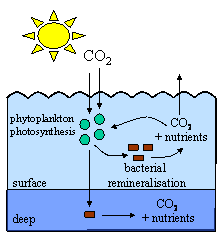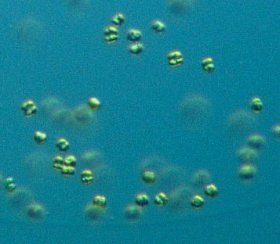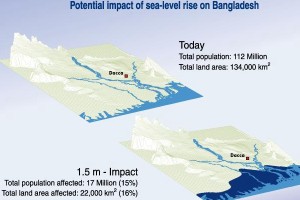 > English > Climate in brief > - Oceans
> English > Climate in brief > - Oceans
Oceans as absorber of light and heat reservoirsSince the Earth receives all energy and heat from the Sun, it is very important for our climate, what happens to the radiation. From own experiences we know that we are for example dazzled by the snow. Ice and snow reflect a major part of the sunlight and appear in light (white) 'colours'. From the black sheet plates of a car we know that it can become rather hot in summer. It absorbs the light and appears in a dark colour, just black. If we have a look on the Earth from the space, we see the same phenomena.
|
|
|
The ice caps of the poles appear in white [3], and also the big deserts [2] in light colours. The oceans and the rain forests [1] are dark. The oceans reflect only about 6% of the sunlight. If you take into account that on a global average about 30% is reflected (the Earth albedo) it becomes clear, that most of the energy from the sun is taken up by the oceans.
|
Ocean currents influence local climateLocations of the same geographical latitude are irridiated in the same way by the Sun. But this does not mean that the climate is comparable, because the land may receive more or less heat depending on the transport of energy by the oceans. Moscow as Hamburg are located between the 53. and 56. degree of latitude. However the winters in Moscow are by far colder than in Hamburg. In the East of the American continent you hardly will find big villages in such regions, since it is too cold. Chilly winters with blizzards and lots of snow happen in Chicago, Toronto and Montreal between 42. and 46. degree of latitude. In Europe you will find there towns as Barcelona, Nice and Rom, that very seldom experience snow at all. |
|
|
The mild European climate is thanks to the gulf stream, an ocean current which conveys warm water from the gulf of Mexico to Europe. At the same time the Newfoundland stream directs the cold water from polar regions to the East coast of North America. In this way the ocean defines the local climate.
|
|
Uptake of carbon dioxideWe would have by far more carbon dioxide in the air, if the oceans would not take up about one third of what human beings produce. Carbon dioxides easily dissolves in water, because it is a polar molecule and can also react with carbonate by forming hydrogen carbonate. Additionally the phytoplankton, tiny plants which live in enormous amounts in the oceans take up carbon dioxide in their lifecycle. Some of the CO2 is released again to the atmosphere when phytoplankton dies and bacteria eat it up. We call this process remineralisation. While photosynthesis leads to the formation of biomass, remineralisation leads to its destruction. Sometimes the bacteria sink into the deep sea and remineralisation takes place there. Here, the carbon can be stored as carbonate sediments for hundreds of years.
|
|
The role of phytoplanktonThe important role of phytoplankton (algae) in the oceans is often underestimated. They do not only take up CO2. If we release too many nutrients into the sea, in particular phosphate and nitrate in the coastal regions, where many people live, we cause a so called eutrophication (over-fertilization).
|
Sea level riseIf climate change and oceans are mentioned, we often think about sea level rise. We are worrying that big parts of the land could be flooded. Present estimations say, that the sea level will rise less than 1 m in the next hundred years. This is a danger only for a few regions in Europe, but for example large parts of Bangladesh could be flooded and millions of people be affected. Also the rich fauna and flora of coral reefs would be lost. It is often thought, that the melting of the polar ice caps due to global warming is the main reason for sea level rise. This is not true. The warming of the air leads to a warming of the oceans and warm water increases in volume. This expansion in volume is the main contributor. Also the melting of inland glaciers contributes, not only the melting of the polar ice. In particular Antarctic ice will not melt so soon.
|
|
|
The topic OCEANS of the climate encyclopaedia explains, how the properties of water and the big ocean streams determine the regional weather on our planet, how phytoplankton living in the sea is involved in gas exchange with the atmosphere and which impact changes in the oceans can have for our climate system.
English proof reading: Sally Taylor, University of Leeds last published: 2005-06-14 |






